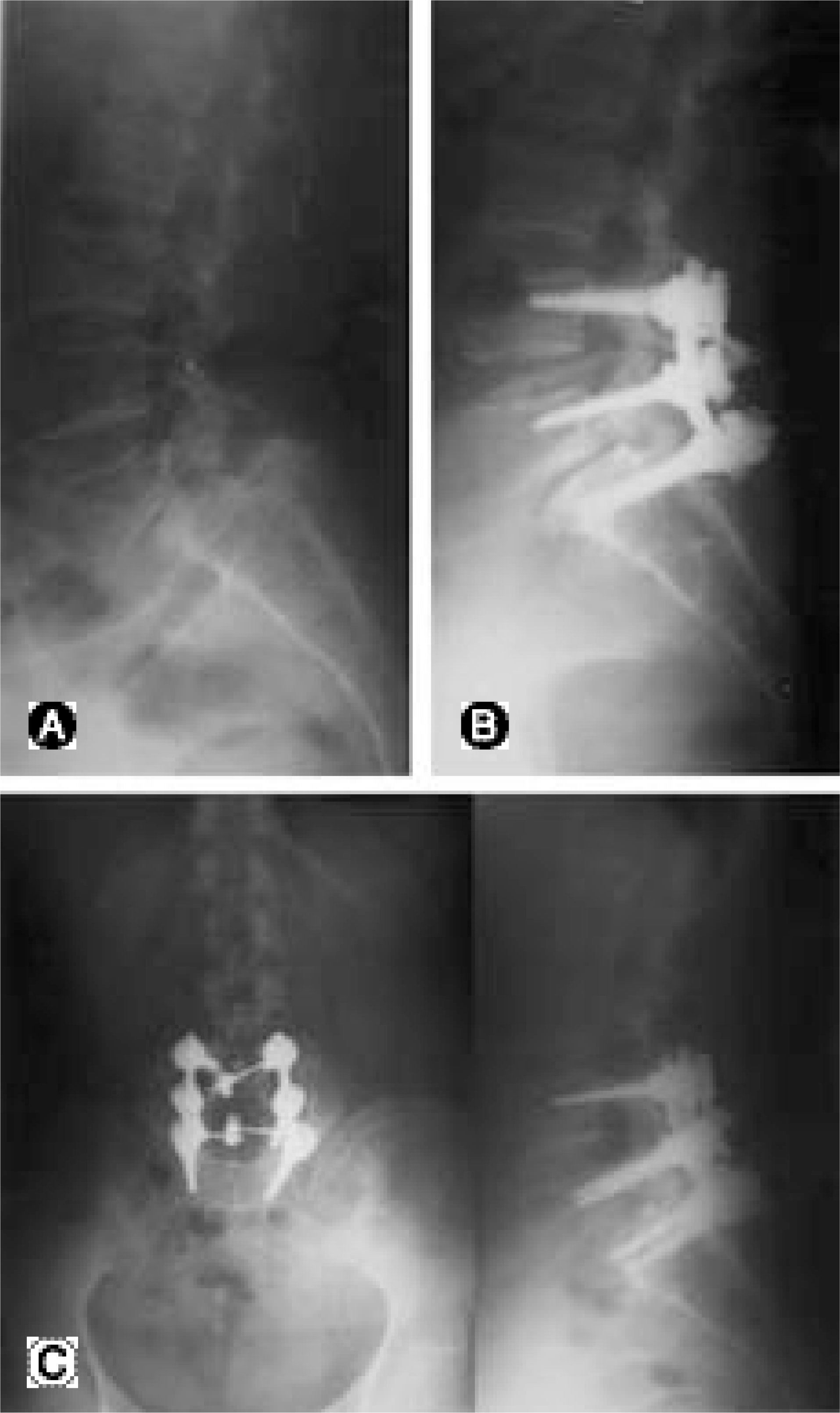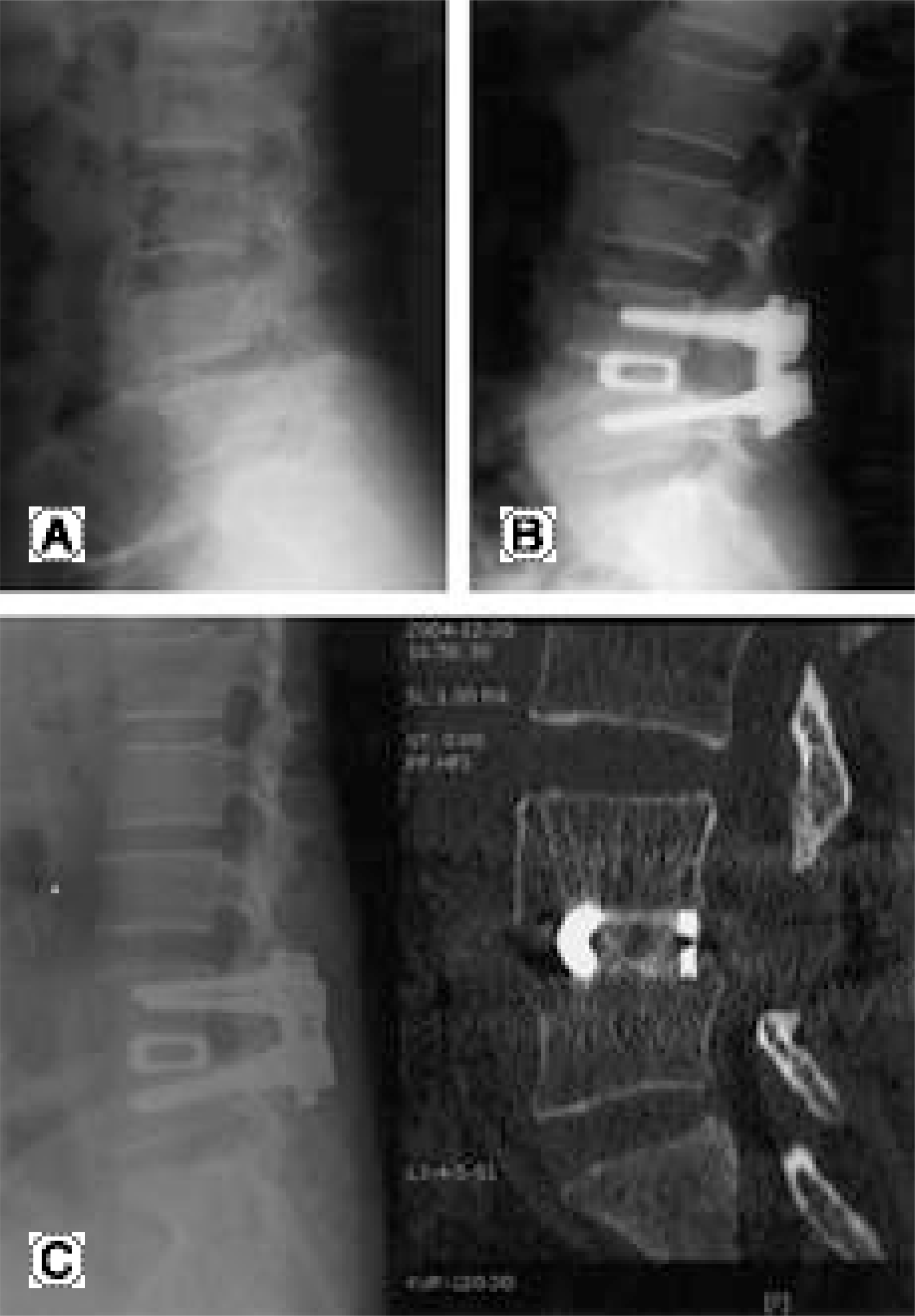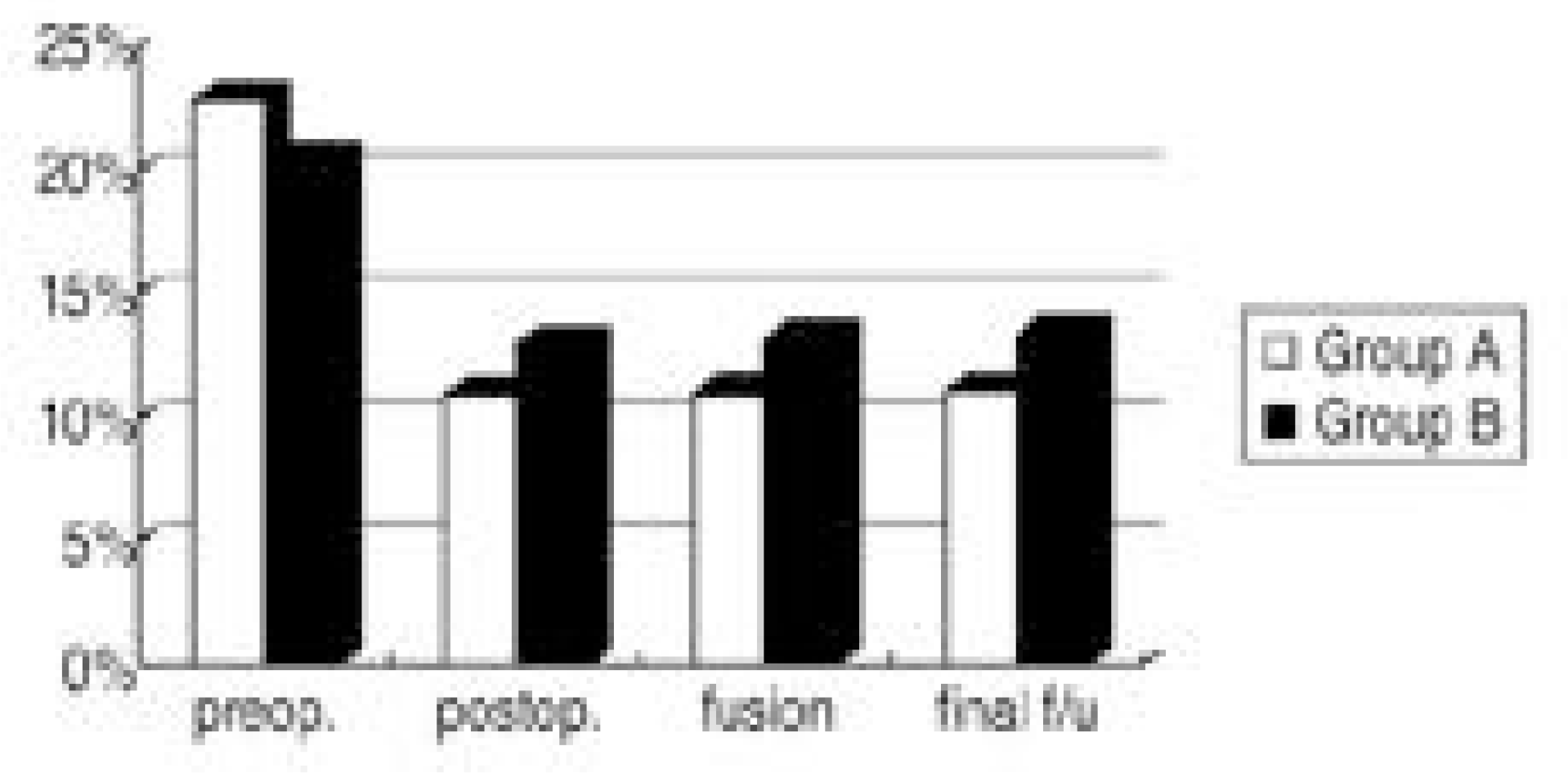Abstract
Study Design
This is a retrospective study on the effect of posterior lumbar interbody fusion for maintaining the reduction in isthmic spondylolisthesis patients.
Objectives
We evaluated the efficacy of performing posterior lumbar interbody fusion for maintaining the reduction in isthmic spondylolisthesis.
Summary of the Literature Review
There have been many reports regarding the surgical treatment of spondylolisthesis. A lthough there are many reports that the clinical results have nothing to do with the reduction, many surgeons have tried to maintain the reduction. However, the question about what kind of fusion modality is the most effective for maintaining the reduction is still controversial.
Material and Method
Between A ugust 2002 and January 2004, 24 patients with isthmic spondylolisthesis were operated on.14 underwent posterolateral fusion alone (group A) and 10 underwent additional posterior interbody fusion (group B). These two groups were compared in terms of the clinical results, the radiological changes and fusion rates. Results: the reduction rate were 11.81% and 7.32% in the PLF and PLF+PLIF groups, respectively (p>0.05). The reduction losses were 0.19% and 0.35% in the PLF and PLF+PLIF groups, respectively (p>0.05). The changes after fusion were 0.11% and 0.10% in the PLF and PLF+PLIF groups, respectively (p>0.05). There was no case of nonunion. The satisfaction rates were 86% and 83% in the PLF and PLF+PLIF groups, respectively (p>0.05).
Conclusions
In our study, the addition of posterior interbody fusion showed no benefit in maintaining correction. If solid fusion can be obtained, then posterolateral fusion seems to be sufficient enough to maintain correction in isthmic spondylolisthesis. The authors think that further studies are mandatory because of the small number subjects in our study.
REFERENCES
1). Shin BJ, Min KD, Kwon H, et al. Surgical result of isthmic spondylolisthesis -comparison of posterolateral fusion vs. PLIF, J Kor Spine Surg. 1996; 3:61–68.
2). Suk SI, Lee CK, Kim WJ, Kim HG. Adding posterior lumbar interbody fusion to pedicle screw fixatin and posterolateral fusion after decompression in spondylolytic spondylolisthesis, J Kor Orthop Assoc. 1995; 30:1638–1646.
3). Choy WS, Kim WJ, Kim KH, et al. The results of the posterior lumbar interboby fusion using titanium mesh cage for spondylolisthesis, J Kor Spine Surg. 1999; 6:129–134.
4). Freeman BJ, Licina P, Mehdian SH. posterior lumbar interbody fusion combined with instrumented posterolateral fusion: 5-year results in 60 patients, Eur Spine J. 2000; 9:42–46.
5). Csecsei Gl, Klekner AP, Dobai J, Lajgut A, Sikula J. Posterior interbody fusion using laminectomy bone and transpedicular screw fixation in the treatment of lumbar spondylolisthesis, Surg Neurol. 2000; 53:2–6.
6). James C.H. Goh, Hee-kit Wong, Ashvin Thambyah, Chun-Sing Yu. Influence of PLIF cage size on lumbar spine stability, Spine. 2000; 25:35–39.
7). Jeon TS, Moon SH, Kim NH, Park KB, Lee HM. Comparison between posterior lumbar interbody fusion with pedicle screw fixation and posterolateral fusion with pedicle screw fixation in spondylolytic spondylolisthesis in adults, J Kor Spine Surg. 2003; 10:104–112.
8). Laursen M, Thomsen K, Eiskjaer SP, Hansen ES, Bunger CE. Functional outcome after partial reduction and 360 degree fusion in grade III-V spondylolisthesis in adolescent and adult patient. J Spinal Disord. 1999; 12:300–306.
9). Madan S, Boeree NR. Outcome of posterior lumbar interbody fusion versus posterolateral fusion for spondylolytic spondylolisthesis, Spine. 2002; 15(27):1536–1542.
10). Mererding HW. Spondylolisthesis: surgical treatment and results. J Bone Joint Surg. 1943; 25:65–77.
11). Taillard WF. Etiology of spondylolisthesis, Clin Orthop. 1976; 117:30–39.
12). Bradford DS. Closed reduction of spondylolisthesis. An experience in 22 patients, Spine. 1988; 13:580–587.

13). Peek RD, Wiltse LL, Reynolds JB, Thomas JC, Guyer DW, Widell EH. In situ arthrodesis without decompression for grade-III or IV isthmic spondylolisthesis in adults who have severe sciatica, J Bone Joint Surg. 1989; 71A:62–68.
14). Cho JL, Yoon WK, Park YS, Choi KJ, Han JH. Redis -placement after operative reduction of spondylolisthesis -comparison between pedicle screw system and Luque ring system-, J Kor Orthop Assoc. 1997; 32:1162–2333.
15). Cho JL, Park YS, Han JH, Lee CH, Roh WI. The changes of adjacent segments after spinal fusion - Follow-up more than three years after spinal fusion -, J Kor Spine Surg. 1998; 5:239–246.
16). Laus M, Tigani D, Pignatti G, et al. P o ste rolat era l spinal fusion: a study of 123 cases with a long-term follow-up, Chir Organi Mov. 1994; 79(1):69–79.
17). McAfee PC, DeVine JG, Chaput CD, et al. The indications for interbody fusion cages in the treatment of spondylolisthesis: analysis of 120 cases, Spine. 30(6 Suppl):S60–65.
18). Sears W. Posterior lumbar interbody fusion for degenerative spondylolisthesis: restoration of sagittal balance using insert-and-rotate interbody spacers, Spine. 2005; 5(2):170–179.
19). Grob D, Scheier HJ, Dvorak J, Siegrist H, Rubeli M, Joller R. Circumferential fusion of the lumbar and lumbosacral spine, Arch Orthop Trauma Surg. 1991; 111(1):20–25.
20). Na HY, Jeong YY, Kim WS, Cho HW. Surgical treatment of isthmic spondylolisthesis: pedicle screw fixation, posterolateral fusion, and posterior lumbar interbody fusion with cage after wide decompression, J Kor Spine Surg. 2003; 10:1199–1207.
21). Spruit M, Pavlov PW, Leitao J, De Kleuver M, Ander-son PG, Den Boer F. Posterior reduction and anterior lumbar interbody fusion in symptomatic low-grade adult isthmic spondylolisthesis: short-term radiological and functional outcome, Eur Spine J. 2002; 11(5):428–433.
22). Kim NH, Lee JW. Anterior interbody fusion versus posterolateral fusion with transpedicular fixation for isthmic spondylolisthesis in adults. A comparison of clinical results, Spine. 1999; 15(8):812–816.

23). La Rosa G, Conti A, Cacciola F, et al. Pedicle screw fixation for isthmic spondylolisthesis: does posterior lumbar interbody fusion improve outcome over posterolateral fusion?, J Neurosurg. 2003 Sep; 99(2 Suppl):143–150.
24). Marchetti PG, Binazzi R, Briccoli A, et al. The surgical treatment of spondylolisthesis, Chir Organi Mov. 1994; 79:85–91.
25). Dehoux E, Fourati E, Madi K, Reddy B, Segal P. Posterolateral versus interbody fusion in isthmic spondylolisthesis: functional results in 52 cases with a minimum follow-up of 6 years, Acta Orthop Belg. 2004; 70(6):578–582.
26). Arand M, Wilke HJ, Schultheiss M, et al. Comparative stability of the “Internal Fixator” and the “Universal Spine System” and the effect of crosslinking transfixating systems. A biomechanical in vitro study, Biomed Tech. 2000; 45(11):311–316.
Fig. 1.
(A) Preoperative lateral radiograph of 49-year-old female shows grade II isthmic spondylolisthesis at L5-S1 level. (B) Postoperative lateral radiograph shows the reduction of spondylolisthesis (48% → 20%). (C) Radiographs at 24 months follow up examination shows maintenance of reduction with solid bony union.

Fig. 2.
(A) Preoperative lateral radiographs of 46-year-old female shows grade II isthmic spondylolisthesis at L4-5 level. (B) Postoperative lateral radiographs shows the reduction of spondylolisthesis (33% → 13%). (C) Radiograph and CT scan at 26 months follow up examination shows maintanace of reduction with solid bony union.

Table 1.
Lenke's fusion grade
Table 2.
Katz's satisfaction scale How Satisfied Are You With:
Table 3.
Loss of Reduction
| Preop. | Postop. | Fusion | Final F/U | Reduction Rate | Reduction Loss | |
|---|---|---|---|---|---|---|
| A | 22.76% | 10.89% | 10.97% | 11.08% | 11.81% | 0.19% |
| B | 20.28% | 12.96% | 13.21% | 13.31% | 07.32% | 0.35% |
| P-value | 00.241 | 0.2810 |




 PDF
PDF ePub
ePub Citation
Citation Print
Print



 XML Download
XML Download